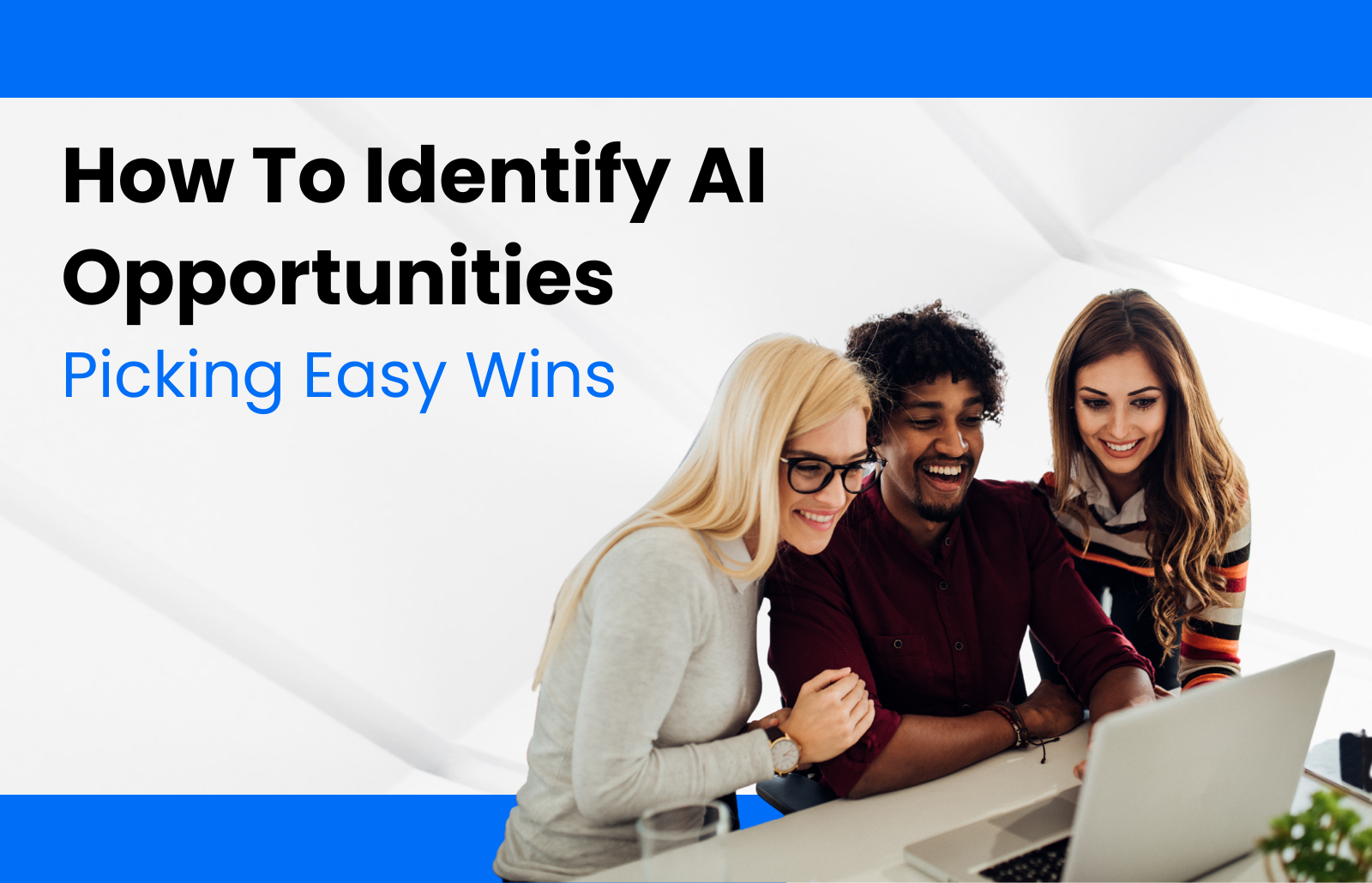The global Artificial Intelligence industry is expected to grow from $136 billion in 2023 to $803 billion in 2030 at a CAGR of 38.1%. AI could increase global productivity by 1.2% per year. This could lead to a significant increase in global living standards over the next few decades.
Artificial Intelligence (AI) has become a transformative force in various industries, offering immense potential for businesses to improve efficiency, enhance decision-making, and gain a competitive edge.
However, identifying the right AI opportunities and achieving “easy wins” in implementation requires a strategic approach. In this article, we will outline a step-by-step plan for identifying AI opportunities and picking those low-hanging fruits that promise substantial returns.
1- Defining the Core Challenge: Key to a Successful AI Project
The foundation of any successful AI project is a well-defined problem. Start by identifying a specific challenge or inefficiency within your organisation. This could range from optimising supply chain logistics to enhancing customer service. It’s crucial to underpin this problem definition with data and statistics.
For instance, if you’re looking to improve customer service, reference real data showcasing customer complaints, resolution times, or service costs. Concrete data not only substantiates the problem but also quantifies its impact.
2- Access Relevant Data
Once the problem is identified, the next crucial step in your journey to leverage AI is accessing the data that will fuel your AI-driven solutions. This data may encompass a wide array of information, including customer profiles, transaction histories, market trends, or historical records. It’s important to understand that the success of your AI project hinges on the quality, quantity, and relevance of this data.
a) Data Types and Sources
Begin by identifying the types of data required for your AI project and where you can source it. Common data types might include:
- Customer data
- Transaction records
- Market data
- Historical databases
b) Data Quality Assurance
Data quality assurance is paramount. In this subsection, delve into the techniques and processes involved in ensuring data quality. Consider these steps:
- Data cleaning and preprocessing: This involves the meticulous process of cleaning and structuring your data to ensure its quality, accuracy, and consistency, which is vital for reliable AI model development.
- Handling missing data: Dealing with missing or incomplete data points is essential to prevent inaccuracies and ensure your AI model’s robustness, often achieved through imputation or data removal strategies.
- Outlier detection and removal: Identifying and eliminating outliers, data points significantly different from the norm, is crucial for maintaining the integrity of your AI model and improving its predictive capabilities.
3- Analyse Risks and Feasibility
AI could create up to 7.8 million new jobs by 2025, but it could also displace 3.8 million jobs. AI could automate 45% of paid activities. 83% of organisations believe that AI will have a significant impact on their industry in the next five years. Only 12% of organisations have a comprehensive AI strategy in place.
AI projects, like any ambitious endeavours, are not without risks. Conducting a comprehensive risk assessment is a fundamental step in your project’s preparation. These risks can take several forms, such as data privacy concerns, technological challenges, or budgetary constraints. However, it’s the identification and mitigation of these risks that often determine the success of an AI project.
a) Risk Identification
Begin by identifying potential risks specific to your AI project. These could include:
- Data privacy risks: These encompass potential issues related to the protection of sensitive data, which is vital for AI projects. Ensuring compliance with data privacy regulations and safeguarding personal information are paramount.
- Technological limitations: These refer to the boundaries and capabilities of the technology being used. It’s crucial to be aware of these limitations to avoid overambitious expectations and plan accordingly to work within those constraints.
- Budgetary constraints: This involves limitations related to the financial resources available for your AI project. Recognizing and managing these constraints is essential to ensure that the project remains on track and within budget.
b) Risk Mitigation Strategies
Strategies for mitigating each identified risk are here;
- Data anonymization or pseudonymization: This involves safeguarding sensitive information by either removing or disguising personal details, ensuring data privacy, and compliance with regulations.
- Technological workarounds or solutions: In the face of technological limitations, these are creative approaches or alternative AI tools that can be employed to overcome challenges and achieve project goals.
- Budget contingency plans: These are financial strategies set in place to account for unexpected expenses or changes in budget, ensuring that the project can adapt to unforeseen circumstances without disruption.
c) Feasibility Analysis
Discuss the feasibility of your project by considering the following:
- Technological Feasibility: Evaluate whether the necessary technology, tools, and infrastructure are accessible and capable of supporting your AI project effectively.
- Resource Availability: Examine the availability of human resources, expertise, and financial means required to execute the project successfully, ensuring that you have the necessary support for its implementation.
- Alignment with Business Goals: Ensure that the AI project aligns with your overarching business objectives and strategies, as it should contribute to your company’s growth and mission.
4- Validate the Value Proposition
Ultimately, the heart of any AI project is its value proposition. The success of your initiative is measured by the tangible benefits it provides. Whether it’s cost savings, revenue generation, or enhanced customer satisfaction, these benefits should be quantified and communicated effectively.
a) Defining Key Performance Indicators (KPIs):
Begin by defining the KPIs that align with your project’s goals. These could include:
- Cost savings percentage: This measures the proportion of costs reduced as a result of your project, indicating its financial efficiency.
- Revenue growth rate: This reflects the percentage by which your project contributes to the increase in company revenue, demonstrating its impact on business growth.
- Customer satisfaction score: This quantifies the level of satisfaction among your customers, a crucial indicator of how well your project meets their needs and expectations.
b) Industry Benchmarking:
Refer to industry benchmarks and standards to validate the value of your project. Include statistics and metrics from comparable projects in your industry.
- Industry-specific benchmarks: To enhance the viability of your AI project, it’s essential to benchmark it against industry-specific standards and best practices. This provides valuable insights into how your project aligns with sector-specific expectations and helps set realistic goals.
- Success metrics from similar projects: Learning from the achievements of similar AI projects can significantly inform your project’s direction. By examining the success metrics of analogous initiatives, you gain valuable guidance for setting performance targets and ensuring the feasibility of your project.
AI Implementation Plan: A Step-by-Step Guide
After you’ve defined the problem, accessed relevant data, and validated the value proposition, the next critical phase is planning the implementation of your AI solution. This phase is where the AI opportunities you are chasing becomes clear and your vision begins to take shape, and the following steps will guide you through it:
Step 1: Data Preparation
Data is the lifeblood of any AI project. Start by ensuring that your data is of high quality and relevant to the problem you aim to solve. This involves data cleaning, data structuring, and data preparation. Here’s what each of these steps entails:
- Data Cleaning: Identify and eliminate any inconsistencies, errors, or outliers in your dataset. This is vital to ensure the accuracy of your AI model’s predictions.
- Data Structuring: Organise your data into a format suitable for AI analysis. This might involve creating data tables, establishing relationships, and handling missing values.
- Data Preparation: Transform the data into a format that AI algorithms can work with. This could involve normalisation, feature engineering, or dimensionality reduction.
Step 2: Model Selection
Choosing the right AI model is a crucial decision that directly impacts the success of your project. It’s essential to pick a model that aligns with the nature of your problem. Consider the following aspects:
- Nature of the Problem: Identify if it is a classification problem, regression, or a more complex task like natural language processing or image recognition.
- Available Data: Some models perform better with small datasets, while others require extensive amounts of data to function effectively.
- Algorithm Selection: Select the specific AI algorithm that best suits your problem. This could be decision trees, neural networks, support vector machines, or many others.
Step 3: Testing and Validation
Once you’ve chosen a model, the next step is to test and validate it rigorously. This involves:
- Testing Data: Set aside a portion of your data for testing, known as the testing dataset. Use this data to evaluate your model’s performance.
- Validation: Employ validation techniques like cross-validation to ensure your model generalises well to unseen data. This step helps to prevent overfitting and ensures your model is robust.
Step 4: Integration
Integration is where the AI solution becomes an integral part of your business operations. Here are the key steps for integration:
- Deployment: Implement the AI solution within your existing infrastructure. This could mean integrating it with your customer relationship management (CRM) system, your website, or other relevant platforms.
- Scalability: Ensure that your AI solution can scale with the growth of your business. If necessary, use cloud-based solutions or scalable architectures.
- User Training: Train your employees or users to understand and work with the AI system. User buy-in and effective utilisation are essential for success.
Step 5: Training and Maintenance
AI models require continuous training and maintenance to stay effective. Here’s what this entails:
- Continuous Learning: Update your model with new data regularly to keep it up to date and ensure that it continues to deliver accurate results.
- Monitoring: Implement monitoring systems to track the performance of your AI solution. If issues arise, they can be addressed promptly.
Step 6: Key Performance Indicators (KPIs)
The success of your AI project should be measured with Key Performance Indicators (KPIs) that align with your business goals. Common KPIs include accuracy, cost reduction, revenue increase, customer satisfaction, and efficiency improvements. These KPIs help you quantify the value your AI solution brings to your organisation.
Implementing an AI solution is a multi-faceted process that requires careful planning and execution. By following these steps, you can navigate the complexities and maximise the potential of your AI project.
Ensure that the integration and maintenance steps are ongoing, allowing your AI system to continuously adapt and deliver value to your organisation.
Illuminating with Examples: AI’s Impact on Business and Beyond
Here are some examples of how AI is already being used to create new opportunities for businesses and individuals:
- AI-powered chatbots are being used to provide customer service and support 24/7. This is freeing up human customer service representatives to focus on more complex issues. 76% of consumers state that they are more likely to buy from a company that offers personalised messaging and services.
- 72% of businesses expect to incorporate AI into their processes within the next 3 years.
- AI is being used to personalise marketing campaigns and product recommendations. This is helping businesses to increase sales and improve customer satisfaction.
- AI is being used to develop new products and services. For example, AI is being used to develop self-driving cars, medical diagnostic tools, and whatnot.
- AI is being used to automate tasks in a wide range of industries, from healthcare to financial services. This is freeing up workers to focus on more creative and strategic activities.
- AI chatbots can automate customer support tasks, such as answering common questions and resolving simple issues.
- AI can be used to detect fraudulent transactions and other suspicious activity. According to a recent study by Juniper Research, AI-powered fraud detection solutions could save businesses $31 billion annually by 2024.
- AI can be used to optimise supply chains, such as forecasting demand and managing inventory levels. AI can help businesses to reduce supply chain costs by up to 15%.
Overall, the evidence suggests that AI is a powerful technology with the potential to create significant opportunities for businesses and individuals. As AI continues to develop, we can expect to see even more innovative and disruptive applications of this technology in the years to come.
Final Verdict
In the dynamic world of AI opportunities, identifying easy wins is the cornerstone of success. The success of any AI initiative depends on the quality of data accessed, the thoroughness of risk analysis, and the clarity of the value proposition. By addressing these aspects comprehensively and supporting them with relevant data and statistics, your path to identifying AI opportunities and securing “easy wins” becomes clearer and more assured.
According to a recent report by McKinsey Global Institute, AI could boost global GDP by $13 to $15 trillion annually by 2030. This is equivalent to an additional 1.1% to 1.4% GDP growth per year.
–
If you have any questions on this topic and would like to learn more on which AI opportunities to prioritise and how you can go about starting your AI journey, we are happy to connect you with our experts. Feel free to reach out now!





